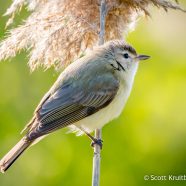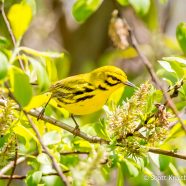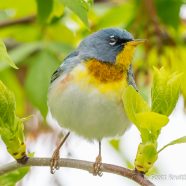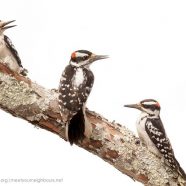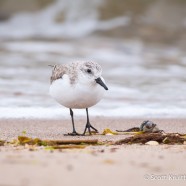Warbling Vireo
One of the more drab and plain May migrant birds in the Northeast is the Warbling Vireo (Vireo gilvus). Their subtle shades of brown, gray and olive combined with their tendency to hang up in the canopy makes it difficult to get an eyeful of the species – and you are far more likely to have an earful of their dynamic, fast and bold warbling song. This individual was foraging on a recent morning at a migratory hotspot, coming to eye-level and pausing on the phragmites just long enough for me to snap a shot. Scott Kruitbosch Conservation & Outreach Coordinator
Read MorePrairie Warbler
This male Prairie Warbler (Setophaga discolor) put on a sensational display for us last Sunday all while singing away and finding plenty to eat after his journey the previous night. It took a few hours to finally see the bird after hearing the rising, buzzy song repeatedly in the morning. The sun was shining brightly high in the sky by the time he came out into the open, giving the yellow warbler an even brighter glow while foraging in these willows. The Prairie Warbler is one of those species that perplexes me in the Chautauqua-Allegheny region. I feel like there should be more of them in...
Read MoreNorthern Parula
Here we have the Northern Parula (Setophaga americana) as photographed while feeding this past Sunday morning after a busy night of migration. These little birds sound like zippers with a hard ending, or sometimes the “That’s all Folks!” song from Looney Tunes after several fast da and be notes. Those white eye crescents stand out from afar on a blue gray bird with a white belly featuring that bright yellow throat and upper chest with a reddish brown band. Northern Parulas are a gleaning species, snatching insects and spiders from tree branches and especially caterpillars...
Read MoreHairy Woodpecker
Here’s the next of the “John James Audubon” series of Meet Your Neighbours shots by RTPI Affiliate Sean Graesser – the Hairy Woodpecker (Picoides villosus). The less common of our backyard black and white woodpeckers, the Hairy Woodpecker is often more elusive despite it being larger than our Downy Woodpecker. They have a larger bill, sometimes described as thorn-like, and feature all white outer rectrices unlike the black barred of the Downys. Photographed for the Meet Your Neighbours global biodiversity project in Connecticut while on assignment for The Roger Tory...
Read MoreSanderling
Here we have a Sanderling (Calidris alba), a bird that spends its winter on our sandy beaches before heading to the High Arctic for the nesting season. They are often misidentified as Piping Plovers during migratory periods as both small, white shorebirds (in nonbreeding plumage for the Sanderling anyway) feed along the water like this. A rufous breeding plumage pattern takes over where the gray is, and by May these birds look unique and spectacular. So much change in so little time…and so much flight distance covered before they nest and head back to us later in the summer. If that...
Read More



